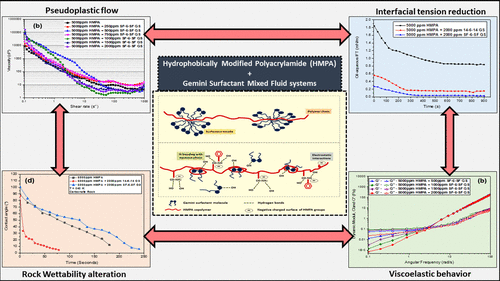Our official English website, www.x-mol.net, welcomes your
feedback! (Note: you will need to create a separate account there.)
Characterization of Hydrophobically Modified Polyacrylamide in Mixed Polymer-Gemini Surfactant Systems for Enhanced Oil Recovery Application.
ACS Omega ( IF 3.7 ) Pub Date : 2019-11-19 , DOI: 10.1021/acsomega.9b02279 Parth Rajeshkumar Bhut 1 , Nilanjan Pal 1 , Ajay Mandal 1
ACS Omega ( IF 3.7 ) Pub Date : 2019-11-19 , DOI: 10.1021/acsomega.9b02279 Parth Rajeshkumar Bhut 1 , Nilanjan Pal 1 , Ajay Mandal 1
Affiliation

|
The study deals with the synthesis and characterization of the hydrophobically modified polyacrylamide (HMPA) copolymer and its functional property evaluation in mixed polymer-gemini surfactant systems for application in enhanced oil recovery (EOR). The copolymer was initially prepared in the laboratory using acrylamide and N-phenylacrylamide monomer units via an addition polymerization route. The synthesized copolymer was characterized by Fourier transform infrared and proton nuclear magnetic resonance to identify suitable functional groups in the compound. Gel permeation chromatography tests showed that the polymer has a molecular weight of 2.098 × 105 Da. Copolymer solution showed favorable tolerance to variations in temperature and salinity. Salt precipitation studies identified tolerance limit up to 25% NaCl at a temperature of 343 K. Viscosity of HMPA fluids showed an increase with increasing concentration. Interestingly, salt addition until 1.0% NaCl showed an increase in solution viscosity owing to the electrostatic shielding of the HMPA polymer and strengthened intermolecular association of the hydrophobic groups. This behavior is against physicochemical properties observed in the case of conventional polymers but exhibits promising functionality in EOR processes wherein better oil mobility control is desired under subsurface conditions. Gemini surfactants accommodate onto "vacant adsorption" sites onto the liquid surface, improving the interfacial adsorption property and reducing surface tension. In the presence of gemini surfactant polymers forming mixed nanoemulsion fluid systems with favorable pseudoplastic character, their viscosities initially increase with surfactant concentration due to binding of surfactant molecules to hydrophobic junctions of polymer chains to form mixed micelles. Eventually, polymer hydrophobes get saturated with surfactant micelles, and viscosity decreases due to electrostatic repulsion among surfactant micelles. Dynamic light scattering analyses confirmed the formation of nanoemulsion droplets with sizes of <310 nm in the case of {surfactant + copolymer} encapsulation. Zeta potential measurements showed that an increase in 14-6-14 gemini surfactant concentration enhanced the stability of nanoemulsion fluid due to increasing zeta potential values. However, the nonionic SF-6-SF surfactant does not affect the zeta potential of nanoemulsions. Surfactant addition reduced the oil-aqueous interfacial tension of polymer solutions to several magnitudes of an order of 10-1 to 10-2 mN/m. Contact angle studies identified the ability of the polymer as well as polymer-surfactant nanoemulsions to alter the wettability of the reservoir rock from the intermediate-wet (90°-120°) to strongly water-wet state (<20°) at different temperatures. Analyzed formulations showed favorable miscibility with crude oil at 343 K. In summary, HMPA/gemini surfactant-based emulsions possess promising physicochemical and stabilization attributes for application in EOR.
中文翻译:

混合聚合物-双子表面活性剂体系中疏水改性聚丙烯酰胺的特性,可提高采油率。
这项研究涉及疏水改性聚丙烯酰胺(HMPA)共聚物的合成和表征,以及在混合聚合物-双子表面活性剂体系中的功能性能评估,以用于提高采油率(EOR)。该共聚物最初是在实验室中通过加成聚合路线使用丙烯酰胺和N-苯基丙烯酰胺单体单元制备的。通过傅立叶变换红外和质子核磁共振表征合成的共聚物,以鉴定化合物中合适的官能团。凝胶渗透色谱法测试表明该聚合物的分子量为2.098×105 Da。共聚物溶液显示出对温度和盐度变化的有利耐受性。盐沉淀研究确定了在343 K的温度下NaCl的耐受极限为25%。HMPA流体的粘度随浓度的增加而增加。有趣的是,由于HMPA聚合物的静电屏蔽和疏水基团的分子间缔合,直到1.0%NaCl的盐添加显示溶液粘度增加。这种行为违背了在常规聚合物中观察到的物理化学性质,但是在需要在地下条件下更好地控制油的流动性的EOR方法中显示出有希望的功能。双子表面活性剂适应液体表面上的“空吸附”位,从而改善了界面吸附性能并降低了表面张力。在双子表面活性剂聚合物的存在下,形成具有良好假塑性特征的混合纳米乳液体系,由于表面活性剂分子与聚合物链的疏水键结合形成混合胶束,它们的粘度最初随表面活性剂浓度而增加。最终,聚合物疏水物被表面活性剂胶束饱和,并且由于表面活性剂胶束之间的静电排斥,粘度降低。动态光散射分析证实在{表面活性剂+共聚物}包封的情况下,形成了尺寸<310nm的纳米乳液液滴。Zeta电势测量表明,由于zeta电势值的增加,14-6-14双子表面活性剂浓度的增加增强了纳米乳液的稳定性。但是,非离子型SF-6-SF表面活性剂不会影响纳米乳液的Zeta电位。表面活性剂的添加将聚合物溶液的油水界面张力降低至10-1至10-2mN / m的数量级。接触角研究确定了聚合物以及聚合物表面活性剂纳米乳剂在不同温度下将储层岩石的润湿性从中湿状态(90°-120°)改变为强水湿状态(<20°)的能力。 。分析的配方显示在343 K下与原油具有良好的混溶性。总而言之,基于HMPA /双子表面活性剂的乳液具有可用于EOR的有希望的物理化学和稳定性。接触角研究确定了聚合物以及聚合物表面活性剂纳米乳液在不同温度下将储层岩石的润湿性从中等湿润状态(90°-120°)改变为强水湿状态(<20°)的能力。 。分析的配方显示在343 K下与原油具有良好的混溶性。总而言之,基于HMPA /双子表面活性剂的乳液具有可用于EOR的有希望的物理化学和稳定性。接触角研究确定了聚合物以及聚合物表面活性剂纳米乳液在不同温度下将储层岩石的润湿性从中等湿润状态(90°-120°)改变为强水湿状态(<20°)的能力。 。分析的配方显示在343 K下与原油具有良好的混溶性。总而言之,基于HMPA /双子表面活性剂的乳液具有可用于EOR的有希望的物理化学和稳定性。
更新日期:2019-12-03
中文翻译:

混合聚合物-双子表面活性剂体系中疏水改性聚丙烯酰胺的特性,可提高采油率。
这项研究涉及疏水改性聚丙烯酰胺(HMPA)共聚物的合成和表征,以及在混合聚合物-双子表面活性剂体系中的功能性能评估,以用于提高采油率(EOR)。该共聚物最初是在实验室中通过加成聚合路线使用丙烯酰胺和N-苯基丙烯酰胺单体单元制备的。通过傅立叶变换红外和质子核磁共振表征合成的共聚物,以鉴定化合物中合适的官能团。凝胶渗透色谱法测试表明该聚合物的分子量为2.098×105 Da。共聚物溶液显示出对温度和盐度变化的有利耐受性。盐沉淀研究确定了在343 K的温度下NaCl的耐受极限为25%。HMPA流体的粘度随浓度的增加而增加。有趣的是,由于HMPA聚合物的静电屏蔽和疏水基团的分子间缔合,直到1.0%NaCl的盐添加显示溶液粘度增加。这种行为违背了在常规聚合物中观察到的物理化学性质,但是在需要在地下条件下更好地控制油的流动性的EOR方法中显示出有希望的功能。双子表面活性剂适应液体表面上的“空吸附”位,从而改善了界面吸附性能并降低了表面张力。在双子表面活性剂聚合物的存在下,形成具有良好假塑性特征的混合纳米乳液体系,由于表面活性剂分子与聚合物链的疏水键结合形成混合胶束,它们的粘度最初随表面活性剂浓度而增加。最终,聚合物疏水物被表面活性剂胶束饱和,并且由于表面活性剂胶束之间的静电排斥,粘度降低。动态光散射分析证实在{表面活性剂+共聚物}包封的情况下,形成了尺寸<310nm的纳米乳液液滴。Zeta电势测量表明,由于zeta电势值的增加,14-6-14双子表面活性剂浓度的增加增强了纳米乳液的稳定性。但是,非离子型SF-6-SF表面活性剂不会影响纳米乳液的Zeta电位。表面活性剂的添加将聚合物溶液的油水界面张力降低至10-1至10-2mN / m的数量级。接触角研究确定了聚合物以及聚合物表面活性剂纳米乳剂在不同温度下将储层岩石的润湿性从中湿状态(90°-120°)改变为强水湿状态(<20°)的能力。 。分析的配方显示在343 K下与原油具有良好的混溶性。总而言之,基于HMPA /双子表面活性剂的乳液具有可用于EOR的有希望的物理化学和稳定性。接触角研究确定了聚合物以及聚合物表面活性剂纳米乳液在不同温度下将储层岩石的润湿性从中等湿润状态(90°-120°)改变为强水湿状态(<20°)的能力。 。分析的配方显示在343 K下与原油具有良好的混溶性。总而言之,基于HMPA /双子表面活性剂的乳液具有可用于EOR的有希望的物理化学和稳定性。接触角研究确定了聚合物以及聚合物表面活性剂纳米乳液在不同温度下将储层岩石的润湿性从中等湿润状态(90°-120°)改变为强水湿状态(<20°)的能力。 。分析的配方显示在343 K下与原油具有良好的混溶性。总而言之,基于HMPA /双子表面活性剂的乳液具有可用于EOR的有希望的物理化学和稳定性。


















































 京公网安备 11010802027423号
京公网安备 11010802027423号